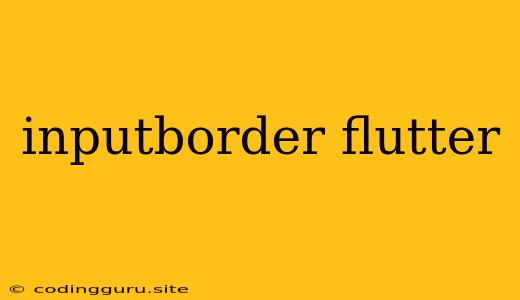Customizing Input Fields in Flutter: A Guide to inputBorder
Flutter, a popular cross-platform framework for building beautiful and performant mobile apps, offers an incredible level of customization. One aspect that often requires fine-tuning is the visual appearance of input fields. This is where the inputBorder property comes into play.
The inputBorder property, found within the InputDecoration class, allows you to control the visual border and appearance of your text fields. It provides a flexible way to achieve diverse styles, from simple outlines to complex shapes.
Understanding inputBorder
Let's delve into the core concepts behind inputBorder.
InputDecoration: The foundation for styling text fields in Flutter. It's responsible for managing elements like the label, hint text, error messages, and, of course, the border.inputBorder: A property withinInputDecorationthat holds the border style configuration. This can be a singleInputBorderobject or a collection ofInputBorderobjects for different states (e.g., focused, disabled).
Types of InputBorder
Flutter provides a few standard InputBorder options:
OutlineInputBorder: Creates a simple rectangular outline around the input field. You can customize its color, width, borderRadius, and more.UnderlineInputBorder: Draws a single underline beneath the input field. Useful for achieving a minimalist look.RoundedRectangleBorder: Creates a rectangular border with rounded corners. This is ideal for creating modern-looking input fields.CircleBorder: Shapes the border into a circle. While uncommon for input fields, this option can be employed creatively for unique designs.
Customizing InputBorder
The real power of inputBorder lies in its ability to be customized. Here are some common customization techniques:
1. Setting Colors:
InputDecoration(
border: OutlineInputBorder(
borderSide: BorderSide(color: Colors.blue),
),
)
This code snippet sets the border color to blue using the borderSide property within OutlineInputBorder.
2. Adjusting Width:
InputDecoration(
border: OutlineInputBorder(
borderSide: BorderSide(width: 2.0),
),
)
Adjust the border width by modifying the width property within borderSide.
3. Rounding Corners:
InputDecoration(
border: OutlineInputBorder(
borderRadius: BorderRadius.circular(16.0),
),
)
Use borderRadius to control the curvature of the border's corners.
4. Adding Gaps:
InputDecoration(
border: OutlineInputBorder(
gapPadding: 8.0,
),
)
The gapPadding property creates a spacing between the border and the input field content.
5. Creating Custom Borders:
For truly unique designs, you can create custom InputBorder objects using the ShapeBorder class. This allows you to define complex shapes, gradients, or any other border design you envision.
Example: A Custom Input Field
import 'package:flutter/material.dart';
class CustomTextField extends StatelessWidget {
final String hintText;
final TextEditingController controller;
const CustomTextField({Key? key, required this.hintText, required this.controller}) : super(key: key);
@override
Widget build(BuildContext context) {
return TextField(
controller: controller,
decoration: InputDecoration(
hintText: hintText,
filled: true,
fillColor: Colors.grey[200],
border: OutlineInputBorder(
borderRadius: BorderRadius.circular(16.0),
borderSide: BorderSide.none,
),
enabledBorder: OutlineInputBorder(
borderRadius: BorderRadius.circular(16.0),
borderSide: BorderSide(color: Colors.grey[400]!),
),
focusedBorder: OutlineInputBorder(
borderRadius: BorderRadius.circular(16.0),
borderSide: BorderSide(color: Colors.blue),
),
),
);
}
}
This example demonstrates a custom input field with a filled background, rounded corners, and different border styles for normal and focused states.
Styling for Different States
InputDecoration allows you to define separate borders for different states of the input field, such as:
enabledBorder: The border style when the input field is enabled.focusedBorder: The border style when the input field is focused.disabledBorder: The border style when the input field is disabled.errorBorder: The border style when the input field has an error.focusedErrorBorder: The border style when the input field is focused and has an error.
By setting these properties, you can provide a visually clear indication of the input field's current state to the user.
Conclusion
The inputBorder property in Flutter empowers you to create visually appealing and functional input fields. By leveraging the available InputBorder types and customization options, you can tailor the look and feel of your input fields to perfectly match your app's design aesthetic.
